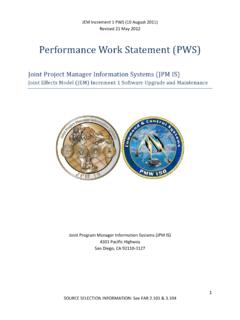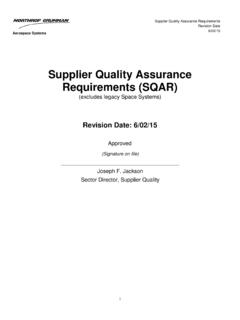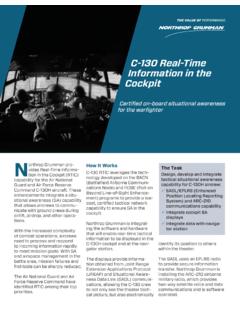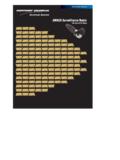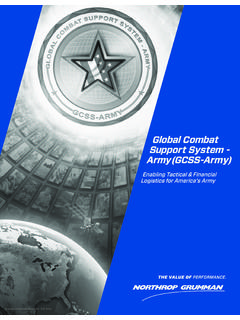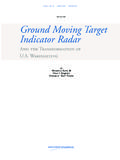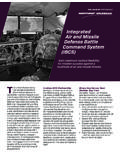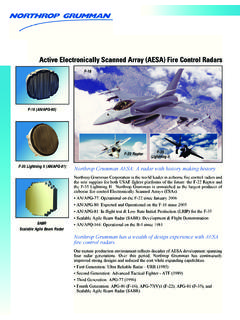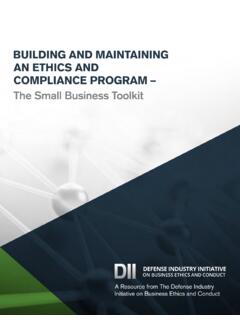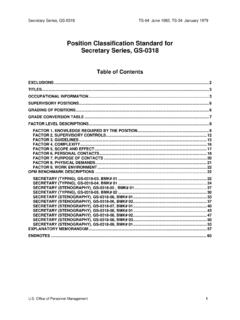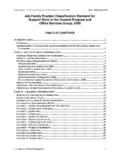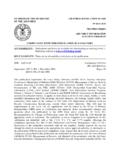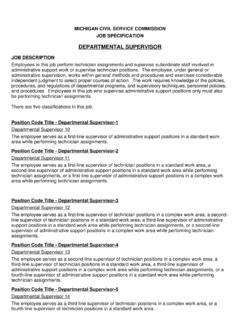Transcription of Derivative Classification Training Job Aid
1 Derivative Classification TrainingJOB AIDC enter for Development of Security ExcellenceLearn. Perform. SECURITY SERVICEUNITED STATES OF AMERICAC enter for Development of Security Excellence (CDSE)938 Elkridge Landing RoadLinthicum, MD 18, 2014 Derivative Classification Training2 Derivative Classification TrainingJOB purpose of this job aid is to provide reference information for the responsibilities and procedures associated with Derivative Classification . This job aid also provides an overview of the approved security Classification documents that assist in analyzing and evaluating information for identification of elements that require the individual links to view each topic. You may also use the forward and backward arrows to navigate through each topic in of Derivative and of Classification and Classification TrainingJOB ClassificationWhile working with classified information, individuals sometimes generate or create new documents and materials based upon that classified information.
2 These individuals who reproduce, extract, or summarize classified information, or who apply Classification markings derived from source material or as directed by a security Classification guide, need not possess original Classification authority. The newly created documents must be classified based upon the Classification level of the information from which the new document was developed. This is defined as Derivative Classification . Derivative ClassifiersThe individuals responsible for applying Derivative Classification to documents are called Derivative classifiers. Derivative classifiers can be either government or contractor classifiers are responsible for maintaining the protection and integrity of classified information. These individuals must possess expertise regarding the subject matter of the classified information, as well as Classification management and marking techniques.
3 Original Classification Authority (OCA) An OCA is an individual occupying a position designated in writing that is charged with making the initial determination that information requires protection against unauthorized disclosure in the interest of national security. When applying Derivative Classification to documents generated from classified information, Derivative classifiers must observe and respect the Classification determination of the Original Classification Authority (OCA).HOMED erivative Classification TrainingDerivative Classification TrainingJOB RequirementsTo accurately apply Derivative Classification , individuals must only use authorized sources. Prior to applying Derivative Classification markings, personnel must be trained in proper application of Derivative Classification classifiers who do not receive Training at least once every 2 years, shall not be authorized or allowed to derivatively classify information until they have received : For additional information, refer to the eLearning course Derivative Classification available through ComponentsTraining in the proper application of the Derivative Classification principles of Executive Order ( ) 13526 must be accomplished, and must emphasize the avoidance of over- Classification .
4 At a minimum, Training should cover the principles of Derivative Classification , Classification levels, duration of Classification , identification and markings, Classification prohibitions and limitations, sanctions, Classification challenges, security Classification guides, and information sharing. HOMED erivative Classification TrainingJOB of Derivative ClassificationThe principles of Derivative Classification are: Use only authorized sources for Classification guidance. The use of only memory or general rules about the Classification of broad classes of information is prohibited. Observe and respect the Classification determinations made by the OCA. Identify yourself by name and position, or by personal identifier, in a manner that is immediately apparent for each Derivative Classification action.
5 Apply standard markings to the derivatively classified material. Take appropriate and reasonable steps to resolve doubts or apparent conflicts about the Classification , level of Classification , and duration of Classification of information. Use caution when paraphrasing or restating SourcesIndividuals should only use authorized sources of Classification guidance which includes: Security Classification Guides (SCG) Properly marked source documents Department of Defense (DD) Form 254 (for Contractors)HOMED erivative Classification TrainingDerivative Classification TrainingJOB and Limitations There are several prohibitions and limitations Derivative classifiers must be cognizant of when applying Derivative Classification . In no case shall information be classified, continue to be maintained as classified, or fail to be declassified in order to: Conceal violations of law, inefficiency, or administrative error; Prevent embarrassment to a person, organization, or agency; Restrain competition; or Prevent or delay the release of information that does not require protection in the interest of national Classification TrainingJOB LevelsAs defined by 13526, information is classified at one of three levels: Top Secret, Secret, or SecretTop Secret Classification shall be applied to information whose unauthorized disclosure could reasonably be expected to cause exceptionally grave damage to the national security that the original Classification authority is able to identify or describe.
6 SecretSecret Classification shall be applied to information whose unauthorized disclosure could reasonably be expected to cause serious damage to the national security that the original Classification authority is able to identify or Classification shall be applied to information whose unauthorized disclosure could reasonably be expected to cause damage to the national security that the original Classification authority is able to identify or Level ReviewClassified documentation is reviewed periodically to determine if the level of Classification should be maintained, upgraded, downgraded, or declassified. HOMED erivative Classification TrainingDerivative Classification TrainingJOB DurationThe duration specified on Derivative documents must respect the duration specified by the most restrictive declassification instruction ( , the one that specifies the longest duration of Classification ) must be carried forward.
7 If the source document or applicable security Classification guide provides no declassification instruction from the OCA, or obsolete or invalid declassification instructions are specified, Derivative classifiers should apply a calculated 25-year duration from the date of the source of Classification DurationExamples of Classification duration include: A date or event 10 years from origination. A date or event up to 25 years. 25X1 through 25X9, with a date or event. 50X1 HUM or 50X2 WMD, or Information Security Oversight Office (ISOO)-approved designator reflecting the Interagency Security Classification Appeals Panel (ISCAP) approval for Classification beyond 50 years. Multiple SourcesWhen using multiple sources, the date or event for declassification that corresponds to the longest period of Classification from either the SCG or source document shall be carried forward for Derivative Classification .
8 When material is derivatively classified based on multiple sources ( , more than one security Classification guide, classified source document, or combination thereof), the Derivative classifier shall compile a list of the sources used. This list shall be included in or attached to the Classification TrainingJOB MarkingsThe Derivative classifier should apply the following guidelines for Classification markings: Classification markings shall be indicated in a manner that is immediately apparent. Each portion of a derivatively classified document shall be marked immediately preceding the portion to which it applies. Information must be marked as one of the three Classification levels defined in 13526 (Top Secret, Secret, or Confidential). The Classified By line must include the name and position, or personal identifier, of the Derivative classifier.
9 All classified documents should include date of origin. Declassification instructions must be included on the : Classified addenda or unclassified versions of documents should be used whenever practicable to facilitate greater information Classifier IdentificationIndividuals who derivatively classify must be identified by name and position, or by personal identifier in a manner that is immediately apparent for each Classification information must be included in the Classified By line. Also, identify the agency and office of origin, if not otherwise evident. HOMED erivative Classification TrainingDerivative Classification TrainingJOB InstructionsClassified documentation is reviewed periodically to determine if the information should be declassified. The date of declassification and duration between reviews is defined in the declassification following guidelines are applicable to declassification instructions: When declassification dates are displayed numerically, the following format shall be used: YYYYMMDD.
10 The date of origin of source documents must also be included with declassification instructions. HOMED erivative Classification TrainingJOB ExampleSECRET//NOFORNOFFICE OF THE UNDER SECRETARY OF DEFENSEINTELLIGENCEMEMORANDUM FOR XXXXXXXXX XXXXXXXXXXXXSUBJECT: (U) Delegation of SECRET Original Classification Authority (OCA) (U) You are hereby delegated authority to classify information up to SECRET forinformation under your area of responsibility in accordance with Executive Order 13526. Classified National Security Information (the Order). (S) As an OCA you are required to receive Training in original Classification as provided by the Order and implementing directives prior to you exercising this Security Manager will facilitate this Training . (S//NF) The order also provides that OCAs shall prepare classissification guides to facilitate the proper uniform Derivative Classification of information.
